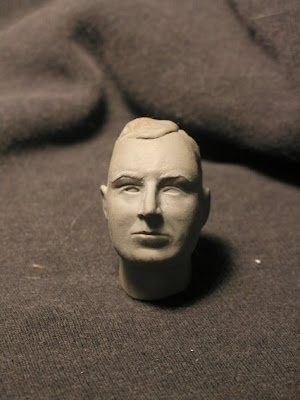My next sculpted bust project is Major General Romeo Dallaire, portrayed as he would have appeared as Force Commander of the United Nations Assistance Mission for Rwanda (UNAMIR) in 1994, during the genocide. Dallaire is now a Canadian with international stature following his performance in command of that failed Chapter 6 UN peacekeeping mission.
 I settled on Dallaire as my next project because he is a change of pace for me (before this the most recent historical figure I had modeled had been from WWII}. Also, I admire him and he presents a challenge with his fascinating craggy face. Finally, the colours of the uniform appeal to be - khaki shirt, green epaulettes, light blue beret. Getting the stressed looked that I see in many pictures of Dallaire will be an additional challenge.
I settled on Dallaire as my next project because he is a change of pace for me (before this the most recent historical figure I had modeled had been from WWII}. Also, I admire him and he presents a challenge with his fascinating craggy face. Finally, the colours of the uniform appeal to be - khaki shirt, green epaulettes, light blue beret. Getting the stressed looked that I see in many pictures of Dallaire will be an additional challenge. He is his own strongest critic, freely admitting his own failings that led in part to the disaster. The worst failing in his eyes was his inability to convince the UN and the international community to intervene. I still recall hearing him pleading for support and to "send me troops!" every week on CBC radio as a country died around him. The West ignored his pleas, afraid to trigger another Somalia fiasco.
He also made a decision on the first night of the genocide that he could not use force to free 10 Belgian para-commandos under his command given insufficient forces and constraining and unrealistic rules of engagement. He had few troops, virtually no ammunition and unarmed observers spread all over the country. As a result, any armed assault to free the hostage Belgians would have breached his orders and resulted many more deaths. In addition, he had only seconds to make the decision. Many Belgians are still bitter that Dallaire did not forceably free these men as they were subsequently brutally murdered.
His book "Shake Hands with the Devil" is a wrenching read and the section where he is ordered to leave by Kofi Anan and to abandon the Rwandans to their own devices is compelling reading. In concert with his African second in command, he refused orders to leave and managed to save perhaps 30,000 to 40,000 souls who had taken refuge with his UNAMIR troops.
As Dallaire's Assistant, Major Brent Beardsley said: "We could have packed up dead bodies, put them on a Herc, flown to New York, walked in the Security Council and dumped them on the floor in front of the Security Council, and all that would have happened was we would have been charged for illegally using a U.N. aircraft. They just didn't want to do anything. ..."
Asked how he can still believe in God after Rwanda, Dallaire responded that in Rwanda he shook hands with the devil and for that reason knows that there is also a God. A fascinating man who is now an international campaigner against genocide and the employment of child soldiers, Dallaire was deeply scarred by his experiences, being diagnosed with PTSD and later attempting suicide three times. You can see his sadnesss and the beginnings of the "1,000 yard stare" in the first photo at the top of this post.
"Rwanda will never ever leave me. It's in the pores of my body. My soul is in those hills, my spirit is with the spirits of all those people who were slaughtered and killed that I know of, and many that I didn't know. … Fifty to 60,000 people walking in the rain and the mud, you know, to escape being killed, and seeing a person there beside the road dying. We saw lots of them dying. And lots of those eyes still haunt me, angry eyes or innocent eyes, no laughing eyes. But the worst eyes that haunt me are the eyes of those people who were totally bewildered. They're looking at me with my blue beret and they're saying, "What in the hell happened? … My failings, my inabilities, not taking advantage, lack of skills, all of it is there. What could I have done better, well, we can discuss that for hours. But there's one thing for damn sure: I was in the field, I commanded, I did not convince, I lost soldiers and 800,000 people died. And there's no way of taking that away. …"











































